Type 2 Diabetes Market Size and Trends
The type 2 diabetes market is estimated to be valued at USD 43.02 Bn in 2025 and is expected to reach USD 73.31 Bn by 2032, growing at a compound annual growth rate (CAGR) of 7.9% from 2025 to 2032.
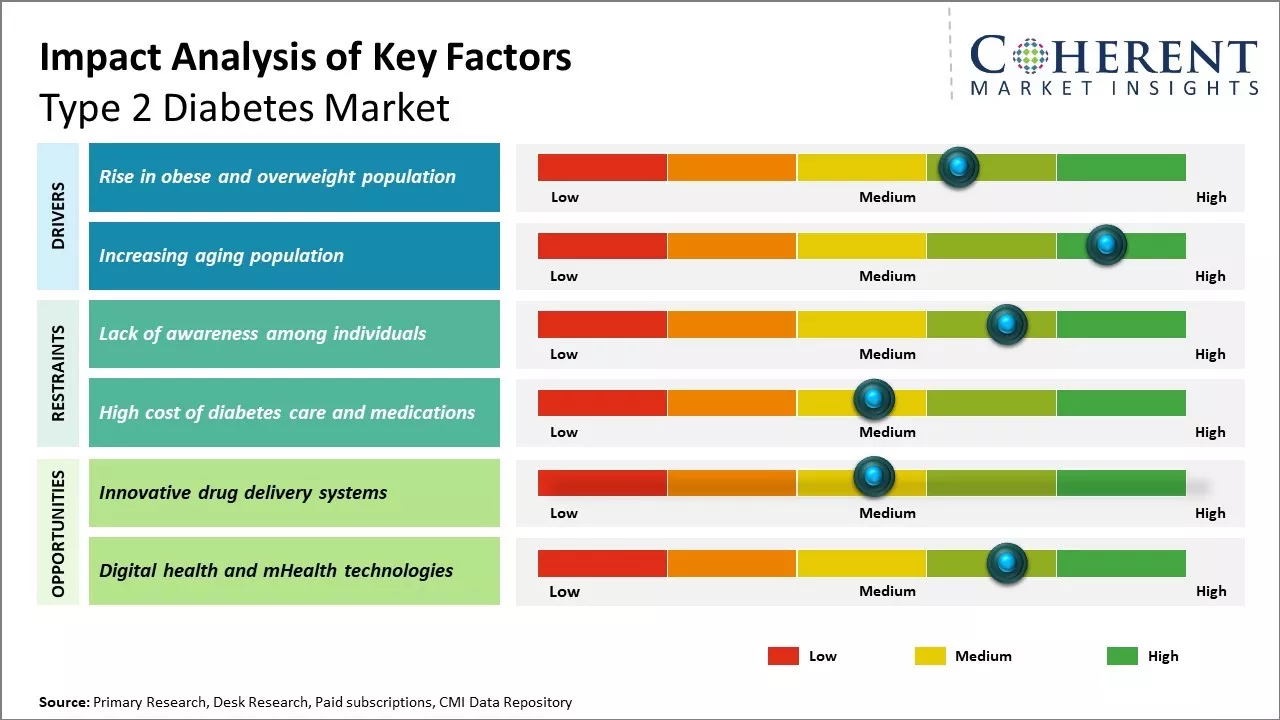
Discover market dynamics shaping the industry: Download Free Sample
The global type 2 diabetes market is witnessing positive trends. With the increasing prevalence of obesity and sedentary lifestyle among the population globally, the risk of developing type 2 diabetes has increased. Moreover, the growing geriatric population prone to sugar-related diseases also contributes to the growth of the market. However, greater awareness among consumers regarding healthy diet and lifestyle changes along with the increasing adoption of advanced insulin delivery devices is expected to provide opportunities for new offerings and treatments in the market. Strong pipeline of novel treatment options can further aid the market growth over the coming years.
Rise in obese and overweight population
The growing prevalence of obesity and overweight population across the globe has become a major public health issue driving the type 2 diabetes market. As per various studies conducted, excess body weight is the main risk factor for type 2 diabetes and majority of new diabetes patients are diagnosed with being overweight or obese. This rising epidemic of obesity can primarily be attributed to changing lifestyle patterns like increased consumption of calorie dense and processed food, lack of physical activity due to sedentary jobs, and urbanization. With busy routines and hectic schedules, people are opting for convenient and high calorie fast foods over home cooked meals which are adding inches to their waistlines. Moreover, children are also following similar lifestyle trends like less involvement in outdoor games and physical education at schools. If this obesity epidemic continues to grow at current pace, it will overwhelm the healthcare systems and economies in the coming decades. As excess body weight directly increases the risk of insulin resistance and diabetes, the expanding obese population base is fueling the demand for diabetes management and treatment. Obese individuals require close monitoring of blood glucose levels and may need early insulin therapy or multiple anti-diabetic drugs to control their blood sugar. This growing diabetic patient pool dependent on life-long treatment is proving beneficial for the diabetes drug market.
Market Concentration and Competitive Landscape
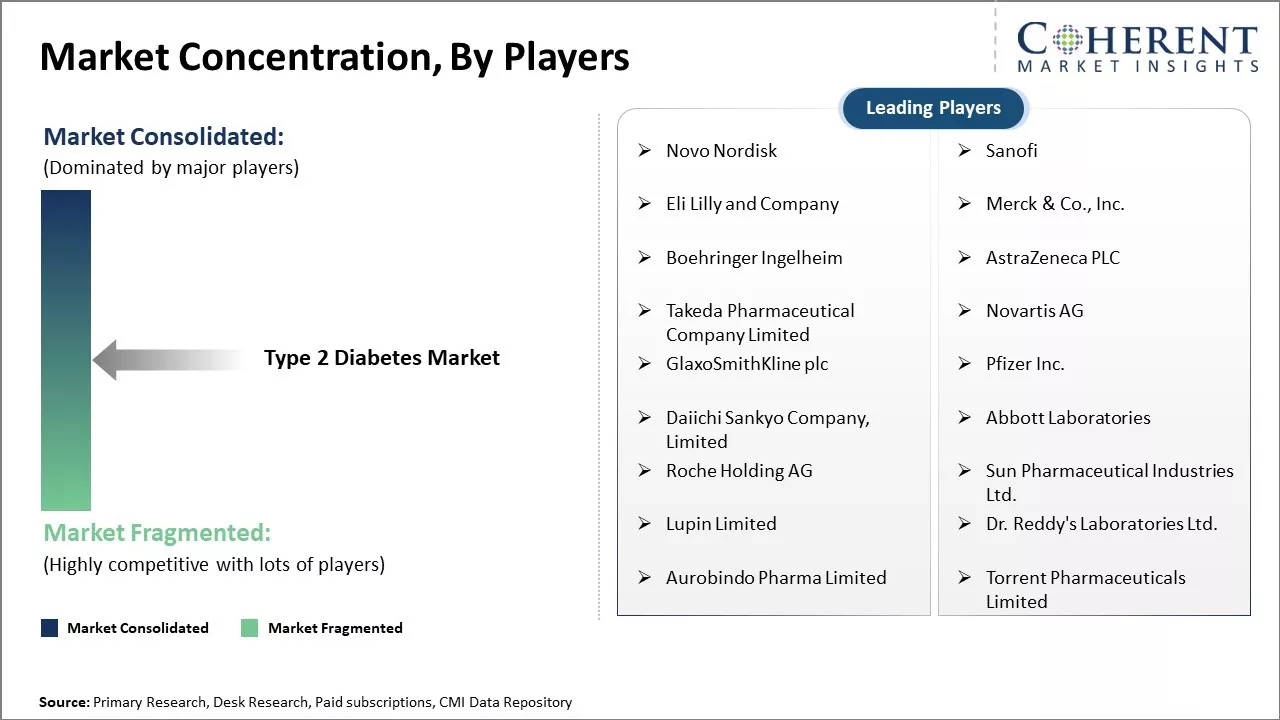
Get actionable strategies to beat competition: Download Free Sample
Increasing aging populationThe aging population is another crucial growth driver for the type 2 diabetes market. As human life expectancy increases worldwide due to advancements in public health and medicine, the geriatric population over 65 years is rising sharply. According to United Nations, between 2015 and 2030, the number of people in the world aged 60 years or over is projected to grow by 56%, from 901 million to 1.4 billion. Region wise too, every continent is witnessing notable surge in their elderly demographic. Aging is a significant risk factor for diabetes as age-related metabolic changes impair body's ability to produce and use insulin efficiently. As people grow older, they tend to gain weight and experience loss of muscle mass, making them more prone to insulin resistance.
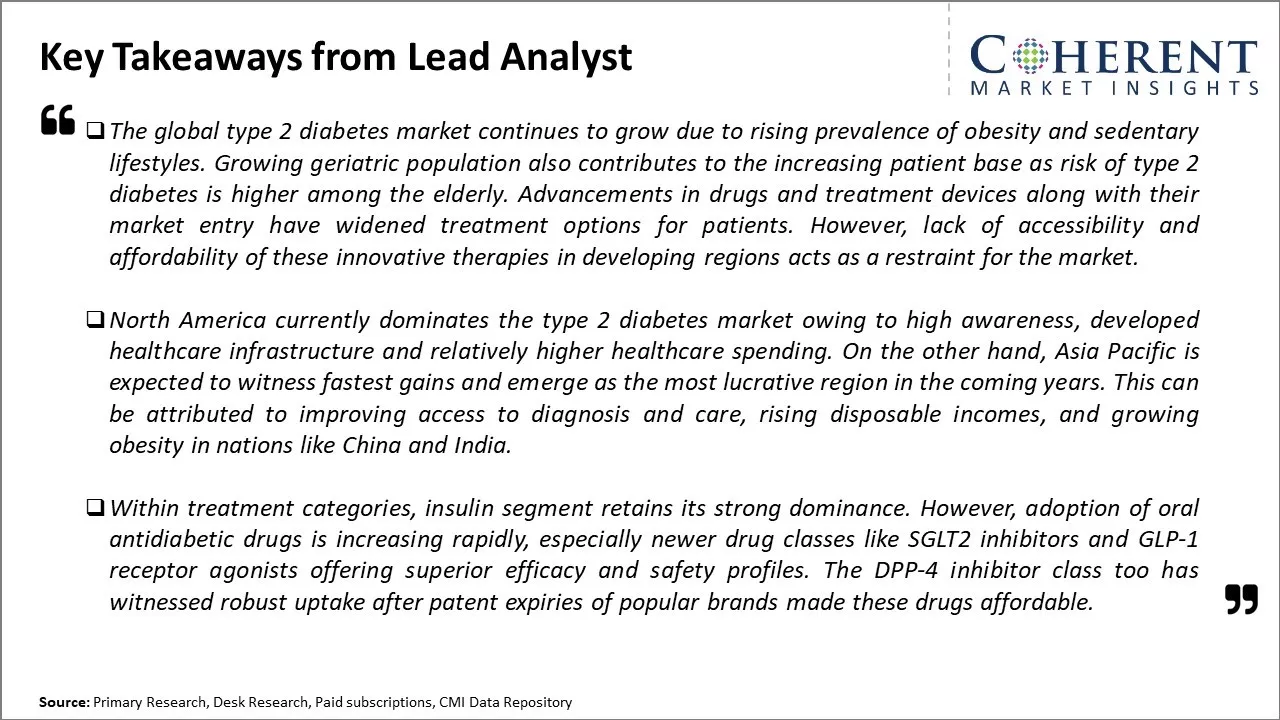
To learn more about this report, Download Free Sample
Market Challenges: Lack of awareness among individualsOne of the key challenges faced in the type 2 diabetes market is increasing awareness among at-risk population groups about preventing the onset of the disease. As type 2 diabetes is often preventable, better education and outreach programs are needed to promote lifestyle changes like healthy diet, exercise and weight management. Further, the rising costs of long-term treatment pose a burden for patients and healthcare systems. Drug adherence also remains a challenge due to complex multi-drug regimens.
Market Opportunities: Innovative drug delivery systems
Advancements in diabetes management through innovative drug delivery systems, new drug formulations, and personalized care tools will help address the needs of heterogeneous patient groups. Telehealth and digital health solutions are transforming diabetes care by facilitating remote monitoring and improving access. Partnerships between stakeholders may help lower treatment costs and enhance prevention strategies.
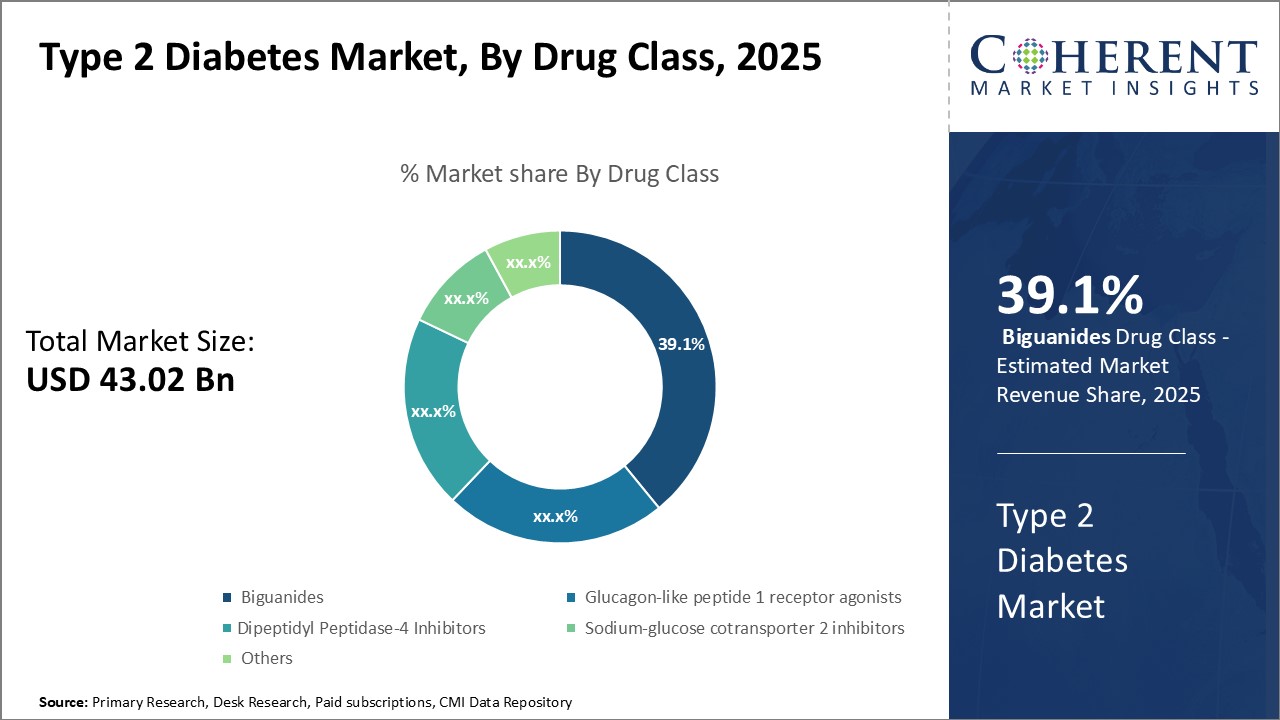
Discover high revenue pocket segments and roadmap to it: Download Free Sample
Market Challenges: Lack of awareness among individualsOne of the key challenges faced in the type 2 diabetes market is increasing awareness among at-risk population groups about preventing the onset of the disease. As type 2 diabetes is often preventable, better education and outreach programs are needed to promote lifestyle changes like healthy diet, exercise and weight management. Further, the rising costs of long-term treatment pose a burden for patients and healthcare systems. Drug adherence also remains a challenge due to complex multi-drug regimens.
Market Opportunities: Innovative drug delivery systems
Advancements in diabetes management through innovative drug delivery systems, new drug formulations, and personalized care tools will help address the needs of heterogeneous patient groups. Telehealth and digital health solutions are transforming diabetes care by facilitating remote monitoring and improving access. Partnerships between stakeholders may help lower treatment costs and enhance prevention strategies.
Insights, By Route of Administration: Convenience drives oral segment growth
The route of administration segment includes oral and parenteral. Oral contributed the highest share of the type 2 diabetes market and is projected to hold 79.3% of the market share in 2025. Oral medications are easier for patients to self-administer without help from healthcare practitioners. This allows for greater independence and flexibility compared to therapies requiring injection. The non-invasive nature of oral drugs also causes less pain or anxiety for patients compared to frequent injections or infusions. This enhanced convenience increases patient compliance for prescribed oral therapies. Physicians also prefer prescribing oral medications when possible due to their user-friendly attributes. These usability advantages give oral therapies a distinctive edge over parenteral alternatives.
Insights, By End User: Home management drives the preference for homecare settings
The end user segment includes homecare settings, hospitals & clinics, academic & research institutes, and others. Homecare settings contributed the highest share of the type 2 diabetes market and is projected to hold 45.3% of the market share in 2025. Homecare allows for the remote monitoring and supervision of type 2 diabetes by healthcare providers while still allowing patients to receive treatment from the comfort of their own home. This enhances convenience and reduces costs associated with hospital or clinic visits. Homecare also empowers patients and caregivers to take a proactive role in managing the condition outside of clinical facilities. Patients appreciate the independence, flexibility and privacy offered by homecare programs. Healthcare providers also benefit from being able to remotely track patient vitals, adherence and respond to emergencies efficiently via digital channels. Overall, the transition towards value-based care and patient-centered approaches is a key factor driving increased preference for homecare settings.
Regional Insights
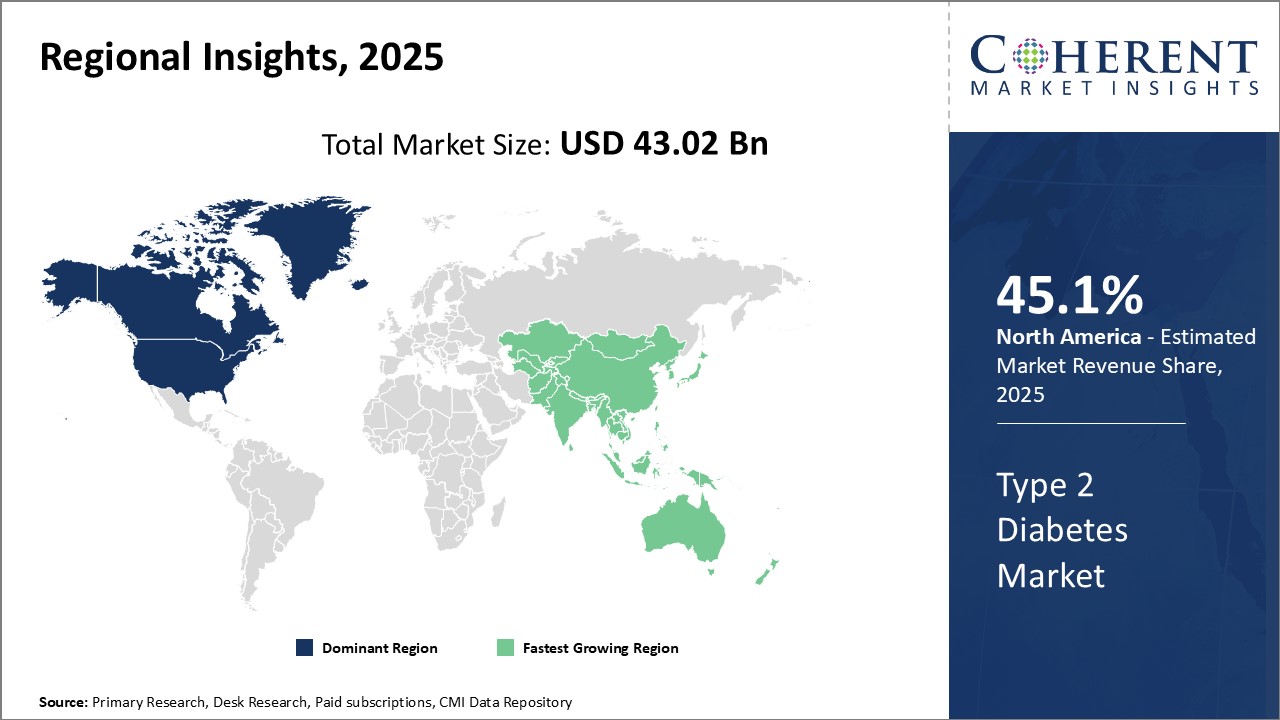
Need a Different Region or Segment? Download Free Sample
North America dominates the global type 2 diabetes market currently and is anticipated to hold 45.1% of the market share in 2025. The U.S. accounts for the largest share primarily due to the increasing prevalence of obesity and sedentary lifestyles among the population. There is high consumption of convenience food items rich in sugar and fat content coupled with lack of physical activity which has significantly contributed to the rise in diabetes cases over the years. Additionally, this region has a well-established healthcare system and people have higher access to advanced medical technologies for effective management of diabetes. Several leading pharmaceutical companies have their headquarters in the U.S. and invested heavily in developing innovative drugs for blood sugar control and related comorbidities treatment.
The Asia Pacific region has emerged as the fastest growing market for type 2 diabetes globally. China and India alone account for a major diabetic population worldwide owing to their large population size and changing demographic trends towards unhealthy diet and lifestyle in recent times. Rising healthcare expenditure, improving access to diagnosis and medications are driving the market in Asia Pacific countries. Many local pharmaceutical manufacturers in China and India are actively engaged in producing affordable generic drugs to cater to the massive diabetic population in this region. Additionally, favorable regulatory environment and guidelines by governments in Asia Pacific countries to curb the burden of non-communicable diseases including diabetes augur well for the future market prospects.
Market Report Scope
Type 2 Diabetes Market Report Coverage
| Report Coverage | Details | ||
|---|---|---|---|
| Base Year: | 2024 | Market Size in 2025: | USD 43.02 Bn |
| Historical Data for: | 2020 To 2024 | Forecast Period: | 2025 To 2032 |
| Forecast Period 2025 to 2032 CAGR: | 7.9% | 2032 Value Projection: | USD 73.31 Bn |
| Geographies covered: |
|
||
| Segments covered: |
|
||
| Companies covered: |
Novo Nordisk, Sanofi, Eli Lilly and Company, Merck & Co., Inc., Boehringer Ingelheim, AstraZeneca PLC, Takeda Pharmaceutical Company Limited, Novartis AG, GlaxoSmithKline plc, Pfizer Inc., Daiichi Sankyo Company, Limited, Abbott Laboratories, Roche Holding AG, Sun Pharmaceutical Industries Ltd., Lupin Limited, Dr. Reddy's Laboratories Ltd., Aurobindo Pharma Limited, and Torrent Pharmaceuticals Limited |
||
| Growth Drivers: |
|
||
| Restraints & Challenges: |
|
||
Uncover macros and micros vetted on 75+ parameters: Get instant access to report
Type 2 Diabetes Industry News
- In June 2023, Pfizer Inc., a multinational pharmaceutical company, announced that it will continue to advance one oral late-stage glucagon-like peptide-1 receptor agonist (GLP-1-RA) candidate into clinical development for the potential treatment of adults with obesity and Type 2 diabetes mellitus (T2DM). Moving forward, the company will advance the clinical program for danuglipron (PF-06882961) based on the outcomes of the ongoing Phase 2 trial, while discontinuing the clinical development of lotiglipron (PF-07081532).
- In April 2023, Eli Lilly and Company, a pharmaceutical company, announced that tirzepatide (10 mg and 15 mg) resulted in more weight loss than placebo after 72 weeks of treatment in SURMOUNT-2. The study found that tirzepatide outperformed placebo in terms of both co-primary and key secondary objectives. The trial included 938 adult volunteers with obesity or overweight and type 2 diabetes.
- In January 2023, Novo Nordisk, a leading global healthcare company, announced that the U.S. Food and Drug Administration (FDA) issued a label update for Rybelsus (semaglutide) tablets 7 mg or 14 mg, allowing use as a first-line treatment option for adults with type 2 diabetes who have not previously taken a diabetes treatment. This update removes a previous use restriction stating that the medicine should not be used as the first line of treatment for people with type 2 diabetes.
- In May 2022, Eli Lilly and Company announced that the U.S. FDA has approved Mounjaro (tirzepatide) injection, a once-weekly glucose-dependent insulinotropic polypeptide (GIP) and glucagon-like peptide-1 (GLP-1 =) receptor agonist indicated as an adjunct to diet and exercise to improve glycemic control in adults with type 2 diabetes. Mounjaro, the first and only S. FDA-approved GIP and GLP-1 receptor agonist, is a single molecule that activates the body's receptors for GIP and GLP-1, both natural incretin hormones.
*Definition: The type 2 diabetes market includes drugs, devices, and accessories to manage and treat type 2 diabetes. This involves oral anti-diabetic drugs like metformin, sulfonylureas, DPP-4 inhibitors, and SGLT2 inhibitors to control blood sugar levels. It also includes insulin therapies, blood glucose monitoring devices like glucometers, test strips, lancets, and control solution.
Market Segmentation
- Drug Class Insights (Revenue, USD BN, 2020 - 2032)
- Dipeptidyl Peptidase-4 Inhibitors
- Glucagon-like peptide 1 receptor agonists
- Biguanides
- Sodium-glucose cotransporter 2 (SGLT2) inhibitors
- Others
- Route of Administration Insights (Revenue, USD BN, 2020 - 2032)
- Oral
- Parenteral
- End User Insights (Revenue, USD BN, 2020 - 2032)
- Homecare Settings
- Hospitals & Clinics
- Academic & Research Institutes
- Others
- Distribution Channel Insights (Revenue, USD BN, 2020 - 2032)
- Hospital Pharmacies
- Retail Pharmacies
- Online Pharmacies
- Regional Insights (Revenue, USD BN, 2020 - 2032)
- North America
- U.S.
- Canada
- Latin America
- Brazil
- Argentina
- Mexico
- Rest of Latin America
- Europe
- Germany
- U.K.
- Spain
- France
- Italy
- Russia
- Rest of Europe
- Asia Pacific
- China
- India
- Japan
- Australia
- South Korea
- ASEAN
- Rest of Asia Pacific
- Middle East
- GCC Countries
- Israel
- Rest of Middle East
- Africa
- South Africa
- North Africa
- Central Africa
- North America
- Key Players Insights
- Novo Nordisk
- Sanofi
- Eli Lilly and Company
- Merck & Co., Inc.
- Boehringer Ingelheim
- AstraZeneca PLC
- Takeda Pharmaceutical Company Limited
- Novartis AG
- GlaxoSmithKline plc
- Pfizer Inc.
- Daiichi Sankyo Company, Limited
- Abbott Laboratories
- Roche Holding AG
- Sun Pharmaceutical Industries Ltd.
- Lupin Limited
- Dr. Reddy's Laboratories Ltd.
- Aurobindo Pharma Limited
- Torrent Pharmaceuticals Limited
Share
Share
About Author
Ghanshyam Shrivastava - With over 20 years of experience in the management consulting and research, Ghanshyam Shrivastava serves as a Principal Consultant, bringing extensive expertise in biologics and biosimilars. His primary expertise lies in areas such as market entry and expansion strategy, competitive intelligence, and strategic transformation across diversified portfolio of various drugs used for different therapeutic category and APIs. He excels at identifying key challenges faced by clients and providing robust solutions to enhance their strategic decision-making capabilities. His comprehensive understanding of the market ensures valuable contributions to research reports and business decisions.
Ghanshyam is a sought-after speaker at industry conferences and contributes to various publications on pharma industry.
Missing comfort of reading report in your local language? Find your preferred language :
Transform your Strategy with Exclusive Trending Reports :
Frequently Asked Questions
EXISTING CLIENTELE
Joining thousands of companies around the world committed to making the Excellent Business Solutions.
View All Our Clients
